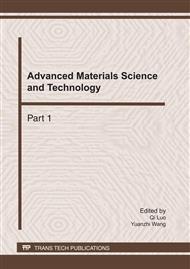p.343
p.349
p.355
p.361
p.366
p.372
p.377
p.383
p.389
Simulation Research on Control Technology of Micro-Particle Adhesion to Surface
Abstract:
The micro particle brings much harm to some industrials, agriculture and human activities. The mechanical models of micro particle adhesion to the surface and the control, disposal technology have become very important for prevention from particle aggradations. For the sake of deeply comprehending and researching the adhesion mechanism as well as kinematics characteristic, numerical simulation of particle adhesion was made based on compute simulation package, the analysis of results and relevant comparison demonstrate that it can well simulate actual state and the results of simulation show that the capillary force (Fc) is the biggest, by contrast, the electrostatic force (Fes) is the smallest. Further more, it has some valuable instructions and helpful references for control of micro-particle adhesion to surface. At last, the outlook of issue was put forward.
Info:
Periodical:
Pages:
366-371
Citation:
Online since:
January 2011
Authors:
Keywords:
Price:
Сopyright:
© 2011 Trans Tech Publications Ltd. All Rights Reserved
Share:
Citation:


